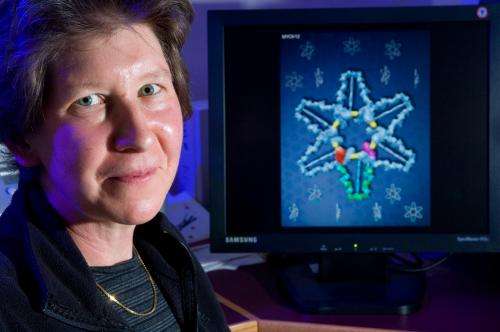Study visualizes mRNA transport in test tube

(Phys.org) —Much of biomedical science – both mystifying and awe-inspiring to the lay public – depends on an unwavering focus on things that can't be easily seen, like the inner-workings of cells, in order to determine how and why disease develops. New research authored by Thomas Sladewski, a University of Vermont graduate student working in the laboratory of Kathleen Trybus, Ph.D., and colleagues, provides a rare "picture" of the activity taking place at the single molecular level: visual evidence of the mechanisms involved when a cell transports mRNA (or messenger RNA) to where a protein is needed to perform a cellular function.
The study appears in the June 30, 2013 Nature Structural and Molecular Biology.
The process of mRNA localization is critical for cellular function. When defects in mRNA transport take place, human diseases, such as spinal muscular atrophy and Alzheimer's disease, can occur. The transport of mRNAs is also important for neuronal development and synaptic plasticity, which is necessary for learning and memory.
According to Trybus, a UVM professor of molecular physiology and biophysics, ensuring proper cellular function is challenging. "The proteins responsible for orchestrating this task are not uniformly distributed, but they often need to be in a certain place at a certain time," she says. That's where mRNA plays a role; cells employ a unique identifier signal in the mRNA called a "zip code" to ensure it transports to the place where the protein is needed.
"Just like the address on a piece of mail, these zip codes help transport the mRNA by linking up with a tiny molecular motor called myosin, which walks on a track called actin, carrying the mRNA to its destination," Trybus explains.
Sladewski says that most mRNAs that are transported actually have multiple zip codes, which is like writing the address four times on a piece of mail. "In our study, one question that we asked is why these mRNAs have so many zip codes when it only needs one to be transported?" he says.
This redundancy, it turns out, is very important. "At the cellular level, recruitment of a myosin motor to a zip code relates to probability," Sladewski explains. A mRNA with one zip code has a probability of engaging with either zero or one myosin motor, but a mRNA with four zip codes will engage with between zero to four myosin motors. In this case, the multiple zip codes – redundancy – ensure that the mRNA will engage with at least one motor and will be successfully transported to its destination.
"You can think of this like shipping a box," says Sladewski. "We normally address only one side of a box so the carrier needs to search up to six sides of the box to find the address, but, if you put the address on each of the six sides, no matter which orientation the box is in, the mailman knows its destination without having to search for it."
To create the visual of these single molecules – mRNPs – moving in real time, Trybus, Sladewski and colleagues reconstructed all of the components essential to transporting mRNA in the cell and then used an imaging technology called total internal reflection microscopy (TIRF).
"mRNPs are really tiny – approximately 1000 times smaller than the width of a human hair – which makes them challenging to see," Sladewski says. In order to see these mRNPs moving on even smaller actin tracks, as well as distinguish the mRNP from the actin, he and the research team attach a miniscule red probe on the actin and a green probe on the mRNP. "When we mix them and image with a sensitive TIRF microscope, we see green mRNPs moving on red actin tracks with high spatial resolution in real time," he says.
"By visualizing single mRNAs being carried to their destination in a test tube, we were able to understand how mRNA is moved in the cell, including how features of the myosin motor, as well as the cargo mRNA being transported, both influence the transport properties of the motor/mRNA complex," Trybus says.
Trybus, Sladewski and colleagues' study has provided a new tool for studying mRNA localization at a molecular level, which will help advance this important field of research.
More information: Single-molecule reconstitution of mRNA transport by a class V myosin, DOI: 10.1038/nsmb.2614
Journal information: Nature Structural and Molecular Biology
Provided by University of Vermont

















